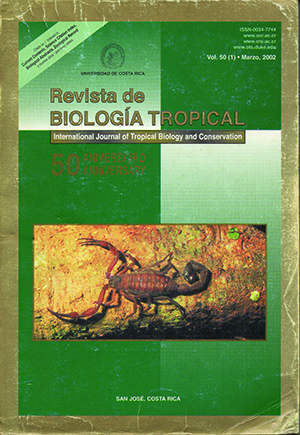Abstract
The helminth infracommunity structure was analyzed in 48 salamanders (Ambystoma lermaensis) from San Pedro Tlaltizapán, Lerma, Estado de Mexico (June 1997 to March 1999). Richness (2.46 ± 1.8), abundance (29.5 ± 42.3), and diversity (0.64 ± 0.58) levels characterize these communities as depauperate, similar to other amphibian helminth communities worldwide. Apparently, the main forces determining infracommunity structure are ectothermy (as regulator of the ingestion rate), and the opportunistic feeding habits of the hosts, because 80% of the helminth taxa enter the host by ingestion of intermediate hosts.##plugins.facebook.comentarios##

This work is licensed under a Creative Commons Attribution 4.0 International License.
Copyright (c) 2002 Revista de Biología Tropical
Downloads
Download data is not yet available.


